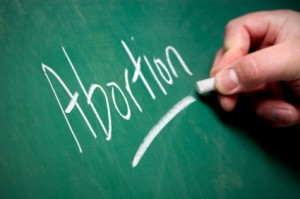Le taux d'avortement aux États-Unis a chuté à son point le plus bas depuis que la Cour suprême a légalisé la procédure dans tous les 50 états, selon une étude suggérant que la nouvelle, longue durée d'action des méthodes contraceptives ont un impact significatif sur la réduction des grossesses non désirées.
Il y avait moins de 17 avortements pour chaque 1,000 femmes en 2011, the latest year for which figures were available, according a paper published Monday from the Guttmacher Institute, a pro-abortion-rights think tank. That is down 13 pour cent à partir de 2008 and a little higher than the rate in 1973, when the Supreme Court handed down its landmark Roe v. Patauger décision.
The study did not examine the reasons for the drop. But the authors suggested that one factor was greater reliance on new kinds of birth control, including intra-uterine devices such as Mirena, which can last for years and are not susceptible to user error like daily pills or condoms.
They also noted the economy as a contributing factor, because people tend to adhere more strictly to their birth control during tough economic times. But they did not credit the recent wave of state laws restricting access to abortion, parce que la plupart de ceux qui ont pris effet en 2011 ou plus tard.
Ces restrictions vont sûrement avoir un impact sur les chiffres allant de l'avant, dit Rachel K. Jones, chercheur principal au Guttmacher et chercheur principal de l'article.
«Si le taux d'avortement continue à baisser, nous ne pouvons pas supposer que c'est dû à des facteurs positifs », comme une meilleure adhérence à la contraception, dit-elle, appelant les lois adoptées dans 22 déclare «onéreuse».
Le rapport intervient alors que les tensions s'intensifient dans le long débat sur l'avortement et la contraception. Les groupes religieux sont enfermé dans une bataille étroitement surveillé avec l'administration Obama sur de nouvelles règles qui obligent les employeurs à offrir le contrôle des naissances gratuitement dans le cadre de leurs programmes d'avantages sociaux de l'assurance maladie. The Supreme Court will decide this year whether employers with religious objections may opt out of those rules.
State legislatures are preparing to push through another raft of restrictive laws, after a record-setting period that saw the enactment dozens of new regulations that critics say will impede women’s access to abortion.
The new laws include requirements that women undergo ultrasounds before obtaining abortions, as well as licensing and inspection requirements for abortion providers.
Nine states banned the procedure after 20 weeks of pregnancy, part of a national effort by abortion opponents to force the Supreme Court to revisit the legality of abortion.
The political clashes, now and over the years, have overshadowed a trend cheered, albeit cautiously, by both sides of the issue: The number of abortions in the United States has been decreasing.
“We are extremely happy that the abortion numbers are going down and continue to be declining over the years,” said Carol Tobias, president of National Right to Life, a prominent antiabortion group.
Such groups, including Tobias’s, reject the Guttmacher Institute’s conclusion that the decrease is not related to state regulations restricting access to the procedure, because while the major surge in new laws came in 2011, some laws came earlier. Par exemple, 39 states require parental notification or consent for a minor to get an abortion.
They say the graphic conversation in the 1990s around the procedure they call “late-term” abortion contributed to a greater awareness of, and horror over, how abortions are performed. And they credit new technologies that allow people to better observe what happens in the womb even at the earliest stages of pregnancy.
“This is a post-sonogram generation,” said Charmaine Yoest, president of Americans United for Life, the group behind many of the new state limits on abortions. “There is increased awareness throughout our culture of the moral weight of the unborn baby. And that’s a good thing.”
Guttmacher researchers said it is unlikely that previous laws had an impact, because they examined the abortion rate in more liberal states that did not enact such laws prior to 2011 and found no difference in the trend.
The study released Monday shows that, after a plateau from 2005 à 2008, the long-term decline in the abortion rate has resumed. The rate has dropped significantly from its all-time high in 1981, when there were roughly 30 avortements pour chaque 1,000 women of reproductive age. The overall number of abortions also fell 13 pour cent à partir de 2008 to nearly 1.1 millions en 2011, the study said.
The results echo a report last year from the Centers for Disease Control and Prevention, which also found a decline in the abortion rate after a plateau. Ce rapport, qui a utilisé une méthode différente, fixé le taux d'avortement 2010 comme 14.6 avortements par 1,000 women of reproductive age.
Le nombre d'avortements ne sont pas faciles à sussed, parce que les fournisseurs ne sont pas tenus de les signaler. La CDC tire de rapports du ministère de la santé de l'Etat, et ses données sont incomplètes. Par exemple, Californie - responsable pour un montant estimé à 17 pour cent des avortements à l'échelle nationale - ne recueille pas de données sur le nombre d'avortements.
Guttmacher s'approche de la tâche différemment, effectuer un recensement périodique en envoyant un questionnaire à tous les fournisseurs d'avortement connus. Ils le suivi par téléphone avec ceux qui ne répondent pas et utilisez la santé département et d'autres données pour combler les lacunes qui subsistent. Le rapport est prêt à être publié dans le numéro de Mars de la revue Perspectives révisées par des pairs sur la santé sexuelle et reproductive.
Experts cautioned that the numbers documented by Guttmacher in the immediate aftermath of Roe v. Patauger may be particularly shaky. Many abortions were still taking place underground and off the books at that time.
Monday’s report showed a shift in women’s preferred method of abortion. Researchers found that nearly one in four of all non-hospital abortions were a result of the abortion pill, à partir 17 pour cent en 2008. The total number of abortion providers declined 4 percent over the same period.
Six states experienced no change or an increase in their abortion rates: Alaska, Maryland, Montana, New Hampshire, West Virginia and Wyoming. Researchers did not explain why those states defied the overall trend.
Source: Washington Post



Pas de commentaire
Commentaires pour Étude: Taux d'avortement au point le plus bas depuis 1973 sont maintenant fermés.